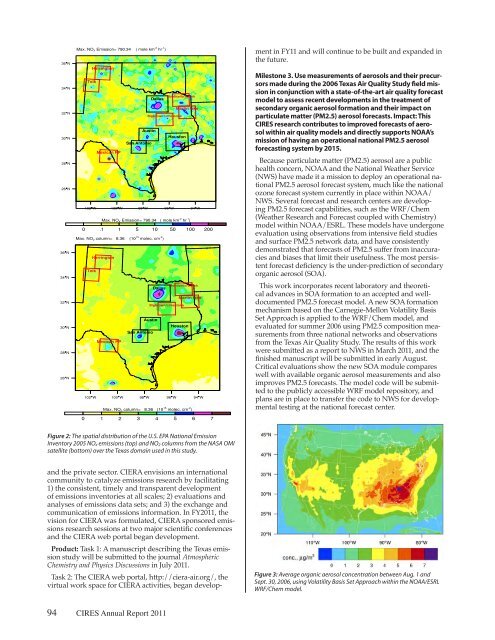2011 - Cooperative Institute for Research in Environmental Sciences ...
2011 - Cooperative Institute for Research in Environmental Sciences ...
2011 - Cooperative Institute for Research in Environmental Sciences ...
You also want an ePaper? Increase the reach of your titles
YUMPU automatically turns print PDFs into web optimized ePapers that Google loves.
1. The spatial Figure distribution 2: The spatial of the distribution US EPA of National the U.S. EPA Emission National Emission Inventory 2005 NOx emissions (top)<br />
Inventory 2005 NOx emissions (top) and NO2 columns from the NASA OMI<br />
O2 columns from satellite the NASA (bottom) OMI over satellite the Texas doma<strong>in</strong> (bottom) used over <strong>in</strong> this the study. Texas doma<strong>in</strong> used <strong>in</strong> this study.<br />
and the private sector. CIERA 1 envisions an <strong>in</strong>ternational<br />
community to catalyze emissions research by facilitat<strong>in</strong>g<br />
1) the consistent, timely and transparent development<br />
of emissions <strong>in</strong>ventories at all scales; 2) evaluations and<br />
analyses of emissions data sets; and 3) the exchange and<br />
communication of emissions <strong>in</strong><strong>for</strong>mation. In FY<strong>2011</strong>, the<br />
vision <strong>for</strong> CIERA was <strong>for</strong>mulated, CIERA sponsored emissions<br />
research sessions at two major scientific conferences<br />
and the CIERA web portal began development.<br />
Product: Task 1: A manuscript describ<strong>in</strong>g the Texas emission<br />
study will be submitted to the journal Atmospheric<br />
Chemistry and Physics Discussions <strong>in</strong> July <strong>2011</strong>.<br />
Task 2: The CIERA web portal, http://ciera-air.org/, the<br />
virtual work space <strong>for</strong> CIERA activities, began develop-<br />
94 CIRES Annual Report <strong>2011</strong><br />
ment <strong>in</strong> FY11 and will cont<strong>in</strong>ue to be built and expanded <strong>in</strong><br />
the future.<br />
Milestone 3. Use measurements of aerosols and their precursors<br />
made dur<strong>in</strong>g the 2006 Texas Air Quality Study field mission<br />
<strong>in</strong> conjunction with a state-of-the-art air quality <strong>for</strong>ecast<br />
model to assess recent developments <strong>in</strong> the treatment of<br />
secondary organic aerosol <strong>for</strong>mation and their impact on<br />
particulate matter (PM2.5) aerosol <strong>for</strong>ecasts. Impact: This<br />
CIRES research contributes to improved <strong>for</strong>ecasts of aerosol<br />
with<strong>in</strong> air quality models and directly supports NOAA’s<br />
mission of hav<strong>in</strong>g an operational national PM2.5 aerosol<br />
<strong>for</strong>ecast<strong>in</strong>g system by 2015.<br />
Because particulate matter (PM2.5) aerosol are a public<br />
health concern, NOAA and the National Weather Service<br />
(NWS) have made it a mission to deploy an operational national<br />
PM2.5 aerosol <strong>for</strong>ecast system, much like the national<br />
ozone <strong>for</strong>ecast system currently <strong>in</strong> place with<strong>in</strong> NOAA/<br />
NWS. Several <strong>for</strong>ecast and research centers are develop<strong>in</strong>g<br />
PM2.5 <strong>for</strong>ecast capabilities, such as the WRF/Chem<br />
(Weather <strong>Research</strong> and Forecast coupled with Chemistry)<br />
model with<strong>in</strong> NOAA/ESRL. These models have undergone<br />
evaluation us<strong>in</strong>g observations from <strong>in</strong>tensive field studies<br />
and surface PM2.5 network data, and have consistently<br />
demonstrated that <strong>for</strong>ecasts of PM2.5 suffer from <strong>in</strong>accuracies<br />
and biases that limit their usefulness. The most persistent<br />
<strong>for</strong>ecast deficiency is the under-prediction of secondary<br />
organic aerosol (SOA).<br />
This work <strong>in</strong>corporates recent laboratory and theoretical<br />
advances <strong>in</strong> SOA <strong>for</strong>mation to an accepted and welldocumented<br />
PM2.5 <strong>for</strong>ecast model. A new SOA <strong>for</strong>mation<br />
mechanism based on the Carnegie-Mellon Volatility Basis<br />
Set Approach is applied to the WRF/Chem model, and<br />
evaluated <strong>for</strong> summer 2006 us<strong>in</strong>g PM2.5 composition measurements<br />
from three national networks and observations<br />
from the Texas Air Quality Study. The results of this work<br />
were submitted as a report to NWS <strong>in</strong> March <strong>2011</strong>, and the<br />
f<strong>in</strong>ished manuscript will be submitted <strong>in</strong> early August.<br />
Critical evaluations show the new SOA module compares<br />
well with available organic aerosol measurements and also<br />
improves PM2.5 <strong>for</strong>ecasts. The model code will be submitted<br />
to the publicly accessible WRF model repository, and<br />
plans are <strong>in</strong> place to transfer the code to NWS <strong>for</strong> developmental<br />
test<strong>in</strong>g at the national <strong>for</strong>ecast center.<br />
Figure 3: Average organic aerosol concentration between Aug. 1 and<br />
Sept. 30, 2006, us<strong>in</strong>g Volatility Basis Set Approach with<strong>in</strong> the NOAA/ESRL<br />
WRF/Chem model.
















